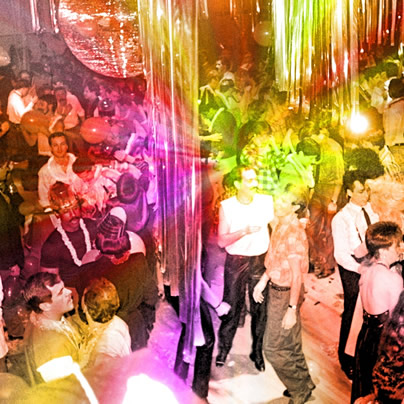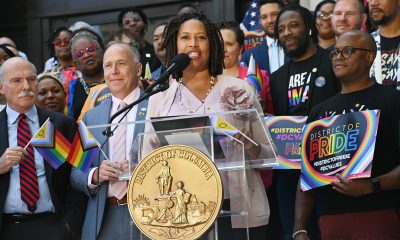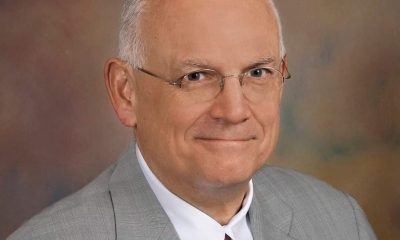Living
Glory days
Tracks — gay nightlife staple of ‘80s/’90s — remembered fondly


Tracks (Washington Blade file photo)
The planning and organizing has taken on all the earnestness and care of a high school or college reunion.
But in a series of events scheduled for this weekend at three D.C. clubs, patrons and employees of a gay nightclub called Tracks — which entertained and some say mesmerized thousands during its run from 1984 to 1999 — will come together for a reunion that may have a far greater meaning for them than a school reunion, according to organizers.
“Tracks nightclub is widely revered as the legendary nightclub of Washington, D.C.,” says a statement on the event’s website, TracksDC.com.
“And although there have been many other nightclubs, parties, events and gathering places that may hold fond memories for many from Washington, Maryland, Virginia and the surrounding region, there is no denying that Tracks meant considerably more to considerably more people for considerably more years than any other nightclub in D.C. history,” the statement says.
Patrick Little, a Tracks bartender and manager and one of the lead organizers of the reunion, said 100 percent of the proceeds for the reunion will go to seven non-profit charitable groups, including Whitman-Walker Health, the House of Ruth shelter for homeless women, the Sexual Minority Youth Assistance League (SMYAL) and the Mautner Project for lesbians with cancer and other serious illnesses.
Other recipients of the proceeds include the AIDS service group Us Helping Us, the D.C. Center and the Metropolis Fund, which raises money to support local and national AIDS causes.
Denver-based businessman Marty Chernoff, founder and owner of Tracks, has been credited with bringing to D.C. a gay nightclub that offered features that no other nightclub offered in the area, gay or straight, from the time it opened in 1984 through at least a decade or longer, Little and others working on the reunion say.

(Washington Blade file photo)
Little and Ed Bailey, who worked as a Tracks DJ and later as its director of promotions, pointed to some of the features of Tracks that set it apart from other clubs. Located in a sprawling warehouse building at 1111 First St., S.E., the club’s main room or hall included the region’s largest dance floor at the time.
Chernoff, who had been operating a Tracks nightclub in Denver, installed in the D.C. club the same state-of-the-art theatrical lighting and sound system he had been using in the Denver club. Chernoff also built in the D.C. club a separate video room with its own dance floor and sound system.
According to Bailey, the video screens were among the largest of any of the existing clubs in the area at a time when video screens were just starting to be installed in clubs in big cities like New York and Los Angeles.
And unlike most other clubs at the time, Chernoff had a large outdoor space as part of the Tracks property in which he installed a volleyball court with beach sand. He also built an 18-inch-deep pool surrounded by a large deck with chairs and an outdoor bar and grill, where hot dogs and hamburgers, among other food items, were served.
The outdoor space also featured yet another dance floor and sound system that became popular in the warm months.
“I built what I thought would work well, including some things where people said, ‘Are you crazy? Who ever heard of a volleyball court in a nightclub?’” Chernoff says. “And I said, ‘Well I tried it in Denver and it worked pretty well. Let’s give it a try here.’”
Bailey and others familiar with Tracks say the volleyball court along with the numerous other amenities at the club worked well, as capacity crowds came to the club on most weekends.
“The video, sound system and lighting were way ahead of their time,” Bailey says. “The music was always cutting edge. And it was far more laid back than other nightclubs.”
Tracks featured nationally known live performers almost once a month for several years. Among them were Gloria Gaynor, Thelma Houston, Crystal Waters, The Village People, Robin Ess, Martha Washington and CeCe Peniston.
Unlike many other gay clubs at the time, Tracks attracted a diverse cross section of the LGBT community, including whites, blacks, men and women, Latinos and Asians, Bailey and Little say. As word got out about Tracks’ grand scale, straights began to come to the club at various times.
Before long, Little says, Friday nights became known as “straight night,” even though gays continued to come to the club on that night.
“It was the biggest, coolest club in the city so other people started going,” Bailey says. “The straight crowd knew it was a gay club but they couldn’t find anything like it anywhere else.”
Chernoff says he and his staff welcomed the diversity of the crowds that packed the club, which sometimes exceeded its occupancy limit of 1,300 people.
He made it clear in no uncertain terms on a sign posted at the entrance that while everyone was welcome, Tracks was a gay club “and if that is a problem for you then you shouldn’t come in.”
“The one absolute we had is we were not going to discriminate,” Chernoff says.

(Washington Blade file photo)
Little says the three nights of the reunion set for this weekend — Friday through Sunday — were put together to reflect the different types of music and crowds that came to Tracks on different nights.
Chernoff says he was especially proud of the lighting system and other features in the Tracks main hall. The enormous dance floor was surrounded by an elevated standing area where people could watch the action on the floor. He arranged for a small platform to be placed high above the main hall dance floor from which a giant mosaic mirrored disco ball was suspended that could be lowered and raised.
A heavy-duty cable was sometimes used to lower performers from the platform above the dance floor. During one of the club’s New Year’s Eve parties, a “heavy-set drag queen dressed only in a diaper” was lowered from the perch above the dance floor “to the hoots and hollers of the crowd below, which was taken by complete surprise.”
Celebrity encounters
Chernoff says one of the “horror stories” he recalls during the years he operated Tracks was when singer Grace Jones, who was booked for a live performance, refused to go on stage when the time for her act was scheduled to begin.
“She was just impossible to work with,” Chernoff says. “She said, ‘I’ll decide if I go on or not go on. I’ll see how I feel about it.’ I said, ‘You owe it your fans out there. Please go on stage.’ She said, ‘I’ll decide if I want to go on or not. Maybe I don’t feel like going on.’ So finally I said, ‘Enough is enough. Just get the hell out of my building. I don’t need to put up with this crap.’”
He says Tracks refunded the money for everyone who paid for admission to see Jones perform, writing off the episode as “one of our biggest disasters.”
Among the most pleasant encounters with a performer or group booked at Tracks was the appearance of the Village People, one of the most popular disco-era acts, especially for gay audiences, Chernoff says.
“It was such a great experience and such a great vibe,” he says. “So after they put the show on they didn’t leave. They stayed and partied with everybody until 5 or 6 in the morning. They said, ‘We don’t want to go home. We’re party people and this is the best party in town.’”
Changing times

(Washington Blade file photo)
“It became a home for a lot of people,” says Reg Tyson, who was part of a group that partnered with D.C. businessman Paul Yates, who bought Tracks from Chernoff around 1990.
“I think it was the right place at the right time,” Tyson says. “It was a new place that allowed people to be free to be themselves, to express themselves.”
The club flourished under Yates’ ownership as Bailey, who had been working as a DJ, was moved by Yates to the post of director of promotions.
Chernoff says around 1996 Yates decided to withdraw from the business, and Chernoff resumed his position as Tracks owner until the time the club closed its doors in 1999. By that time Bailey had left Tracks to become involved with a new and even bigger nightclub located one block away called Nation, which started a Saturday night gay dance party called Velvet Nation.
“Like everything else, Tracks’ time had come,” Chernoff says. “You can’t hang on to the previous concept and expect it to move into the next decades and next generations. What made Tracks unique and phenomenal — it had run its course.”
Ongoing negotiations with a developer that had expressed interest in buying the Tracks property to build a new office building reached the stage where a deal was finalized, Chernoff says.
Bailey says he was honored to have worked for Chernoff and credits him with teaching him the ins and outs of operating a nightclub, skills that Bailey says helped him in his work at Nation.
“Tracks innovated the nightclub scene in a way that Nation benefited,” Bailey says.
Bailey says he was also honored that Chernoff and the Tracks staff invited him to work as DJ at Tracks during its closing night party in November 1999.
Kevin Brennan, a Tracks customer who was later hired as a lighting technician at the club, says he and his partner of 18 years, Don Oberholzer, have especially fond memories of Tracks.
“That’s where we met,” Brennan says. “I think he was dancing on one of the dance boxes in the big room and we just started talking.” They had their first date about a week later and have been a couple ever since. The two were married in D.C. last year.
“It made an impression on me in the sense that nothing else has ever compared,” Brennan says of the club. “I never felt like there was another club that had everything that Tracks had.”
Autos
Sporty sedans: BMW 530i xDrive, Mercedes AMG CLA 3
Tariffs are here and the result is financial chaos

It’s official: Tariffs are here, and the result is financial chaos.
So, what to do when purchasing a new vehicle? If you need one in the not-so-distant future, buy sooner (like yesterday) rather than later. Expect prices to rise quickly, as inventory dwindles, demand soars, and automaker incentives evaporate. Of course, if a new ride isn’t a priority for at least a year or three, then hold off until the dust settles.
But for those of you looking for new wheels now, I recently drove two sport sedans that were a pleasant reprieve from the usual plethora of pickups, minivans, and SUVs.
BMW 530i xDRIVE
$63,000
MPG: 28 city/35 highway
0 to 60 mph: 5.5 seconds
Cargo space: 18.4 cu. ft.
PROS: Rakish looks. Race-car vibe. Rock-star amenities.
CONS: Rad-but-quirky infotainment system. Rich price.
IN A NUTSHELL: Classic good looks, from the iconic grille and swept-back headlights to chiseled side panels and a tasteful tush. For a gearhead like me, the BMW 530i xDrive — completely redesigned last year — is as rapturous as Michelangelo’s David. Everything here is in proportion, from the design to the drivetrain, which — along with a gutsy 255-hp turbo and all-wheel drive — helps deliver a divine experience behind the wheel. Even better, my test car came equipped with the heavenly M-Sport Package: 21-inch wheels, athletic suspension, and assorted styling upgrades.
A tech-laden cabin is outfitted with a sparkly 12.3-inch digital instrument cluster and 14.9-inch touchscreen infotainment system. With the windshield head-up display and a slew of knobs and toggle switches in the center console and on the steering wheel, I wondered if this is how it feels to pilot the Space Shuttle. There is even a back-lit interaction bar with touch-sensitive controls to adjust vent direction and other climate control settings.
All this gadgetry takes some getting used to, but the overall effect is dazzling. While a 12-speaker Harman Kardon stereo comes standard, I was jammin’ to the 16-speaker Bowers & Wilkins premium audio. Of course, such options add up quickly (on my test car, the extras totaled $13,000).
Just how fun is this car? In my favorite episode of “Hacks,” sassy Jean Smart drives a rockin’ Rolls Royce Wraith. Trust me, this four-door BMW is every bit the badass as that $300,000 super coupe.
MERCEDES AMG CLA 35

$58,000
MPG: 22 city/29 highway
0 to 60 mph: 4.8 seconds
Cargo space: 11.6 cu. ft.
PROS: Slick styling. Spiffy cabin. Sublime seats.
CONS: Smallish trunk. So-so rear headroom and legroom.
IN A NUTSHELL: Need a smaller sedan that’s just as marvy as the midsize BMW i530? Look no further than the compact Mercedes CLA-Class, which is 14 inches shorter. That’s a benefit when jockeying for parking or navigating rush hour.
Another plus: This is Mercedes’s least expensive sedan, available in three trim levels. All come with the same potent turbo but in varying power levels. The base model starts at $46,000, but I tested the first of two high-performance versions: the AMG CLA 35, which costs $12,000 more. You can open your wallet even further to snag the $67,000 AMG CLA 45.
But why bother? The AMG CLA 35 is plenty quick — faster than the BMW i530 — and boasts sport-tuned brakes, deft handling and a gritty-sounding exhaust system. The laundry list of standard features includes all-wheel drive, automated parking, gobs of the latest safety gizmos and even something called “safe-exit assist,” which prevents passengers from opening a door into traffic or speeding cyclists.
The interior is pure Mercedes, with top-notch materials, customizable ambient lighting and Burmester surround-sound audio. The overall layout—sleek and modern, but with elegant stitching in the seats and on the door panels and dashboard—is comfortable and user-friendly. Digital displays and touchscreens are similar to what’s in the BMW i530, just smaller.
Size matters, of course, which is why this vehicle’s shorter length can be a blessing but also a curse, especially when trying to squeeze passengers with longer legs into the backseats. And the dramatically sloped roofline, attractive from the outside, limits the amount of rear headroom and cargo space. Thank the automotive gods for panoramic sunroofs, which—at least for anyone in the front seats—makes this cabin feel surprisingly spacious.
Real Estate
Spring updates to sell your home for pride and profit
Consider new landscaping, power washing, creative staging

Selling a home is a big deal for anyone, but for members of the LGBTQ+ community, it comes with unique considerations—from finding affirming professionals to ensuring your home is represented in a way that reflects your values. Whether you’re a first-time gay home seller or a seasoned LGBTQ+ homeowner looking to move up, maximizing your home’s value is key to a successful and empowering sale.
Here’s how to prepare your home, your mindset, and your real estate strategy to get the most value—financially and emotionally—from your home sale.
1. Start with an LGBTQ+-Friendly Real Estate Agent
Before diving into renovations or staging, make sure your agent truly understands your needs. A gay-friendly or LGBTQ+-affirming real estate agent brings more than just market expertise—they bring cultural competence, safety awareness, and a network that supports you throughout the selling process.
At GayRealEstate.com, you can find experienced, vetted LGBTQ+ real estate agents who have been proudly serving the community for over 30 years. Working with someone who shares or supports your identity ensures your selling journey is respectful, inclusive, and effective.
2. Enhance Curb Appeal—With a Welcoming Vibe
The outside of your home is the first impression a potential buyer gets. Make it count—especially for LGBTQ+ buyers looking for a home that feels safe and welcoming.
- Fresh landscaping: Add colorful flowers, neatly trimmed shrubs, or low-maintenance greenery to appeal to eco-conscious buyers.
- Update the entrance: A new front door, stylish lighting, or even a rainbow doormat can make your home feel like a safe space from the start.
- Clean and repair: Power wash the exterior, touch up paint, and make any necessary repairs to gutters, windows, or siding.
3. Stage with Intention and Inclusivity
Home staging can add thousands to your sale price. But beyond the usual decluttering and neutral palettes, think about how your space tells a story—and who it’s telling it to.
- Create a warm, inclusive feel: Subtle touches like LGBTQ+ art, books, or even coffee table magazines can show off your personality and affirm the space for queer buyers.
- Depersonalize—but don’t erase: You don’t need to hide your identity to appeal to buyers. Let your home feel lived in and loved—while still being a blank canvas others can imagine themselves in.
- Highlight multi-use areas: Home offices, gender-neutral nurseries, or flex spaces resonate with LGBTQ+ families and professionals.
4. Update Kitchens and Bathrooms Strategically
These rooms matter most to buyers—and even small updates can yield big returns.
- Kitchen: New cabinet hardware, a fresh backsplash, and modern lighting can elevate the entire room without a full remodel.
- Bathroom: Replace old fixtures, re-caulk tubs and sinks, and add plush towels and inclusive décor.
- Energy-efficient upgrades: Touchless faucets, smart appliances, or low-flow toilets are not only trendy—they signal sustainability, which matters to LGBTQ+ buyers.
5. Make Your Home More Energy Efficient
LGBTQ+ homebuyers often prioritize sustainability. These updates not only reduce energy bills but make your home more marketable.
- Install a smart thermostat (like Nest or Ecobee)
- Upgrade insulation or windows
- Consider solar panels (especially in sun-drenched regions like California or Florida)
Bonus: You may qualify for state or federal tax credits, which can be a great selling point.
6. Know and Advocate for LGBTQ+ Housing Rights
Although housing discrimination is illegal under the Fair Housing Act, it still happens. As an LGBTQ+ seller, be aware of your rights—and those of potential buyers.
- Avoid steering or bias: Even with good intentions, make sure you’re not inadvertently influencing who views or buys your home based on identity.
- Work with affirming professionals: From inspectors to lenders, choose partners who support inclusive practices.
- Report discrimination: If you or a buyer encounters bias, report it to HUD or your local housing authority.
7. Price Your Home Right—and Market It Smartly
Setting the right price is essential to maximizing value. Your LGBTQ+-friendly agent can run a comparative market analysis, considering current trends and buyer demographics.
- Leverage LGBTQ+ real estate networks: Promote your home through platforms like GayRealEstate.com to reach an audience that understands and values your space.
- Use inclusive language in listings: Avoid gendered terms or heteronormative assumptions. Instead of “his and hers closets,” use “dual walk-ins” or “double closets.”
- High-quality photos and video tours: Showcase your home with professional, visually inclusive marketing that appeals to diverse buyers.
8. Consider Timing and Local LGBTQ+ Trends
Selling during WorldPride or just before local LGBTQ+ events may boost visibility. Also consider if you’re in or near an LGBTQ+ friendly city or neighborhood.
Not sure which areas are top destinations? GayRelocation.com tracks and shares the best cities for LGBTQ+ homebuyers, helping you tap into motivated buyers.
Final Thought: Sell with Confidence—and Community
Selling your home isn’t just about getting top dollar—it’s about closing a chapter with pride and integrity. When you center your values, work with LGBTQ+ affirming experts, and prepare your home with purpose, you’re not just maximizing your home’s value—you’re creating an empowering experience for yourself and the next owner.
Whether you’re buying, selling, or both—GayRealEstate.com is your trusted partner in every step of your journey. With a nationwide network of gay and lesbian realtors, decades of experience, and deep community ties, we ensure your home transition is safe, smart, and full of pride.
GayRealEstate.com is the nation’s leading online platform connecting LGBTQ+ home buyers and sellers with LGBTQ+ friendly real estate agents, ensuring a safe and supportive experience.
Scott Helms is president of GayRealEstate.com. To find an agent or learn more, visit GayRealEstate.com, GayRelocation.com or call 1-888-420-MOVE.
Real Estate
Navigating DMV real estate market during political unrest
Reductions in federal employment have introduced uncertainties

The Washington, D.C.-Maryland-Virginia (DMV) region has long been recognized for its robust housing market, underpinned by the presence of the federal government and a diverse economic landscape. Recent massive reductions in federal employment have introduced uncertainties, yet the area continues to offer compelling reasons for prospective homebuyers, particularly within diverse communities.
While the federal government has traditionally been a significant employer in the DMV, the region has proactively diversified its economic base. Sectors such as technology, professional services, education, and healthcare have expanded, mitigating the impact of federal job cuts. This diversification fosters some economic resilience, which offers our area a semblance of protection against the impending unknowns that we currently face. Nothing can shield real estate entirely; however, our area tends to survive these types of changes better than other parts of the country.
Despite concerns over federal layoffs, the DMV housing market has demonstrated notable stability. Analyses indicate that the number of active listings, sold properties, and median sales prices have remained steady on a year-over-year basis. This steadiness suggests that the market is adapting to changes without significant disruption.
Furthermore, while there has been a slight increase in home listings, this trend aligns with typical seasonal variations and does not solely reflect federal employment changes. The luxury property segment, in particular, continues to thrive, indicating sustained interest and investment in the region.
The DMV region is renowned for its cultural and demographic diversity, with areas like Montgomery County, Md., being among the most ethnically diverse in the nation. This inclusivity extends to various communities, including LGBTQ individuals, fostering a welcoming environment that enhances the area’s appeal. Even though the current administration is fostering anti-diversity ideology, I remain confident that our LGBTQ community will continue to thrive even as these destructive forces work against us.
Local governments within the DMV have implemented policies aimed at promoting affordable housing and preventing displacement, particularly in the wake of economic shifts. Initiatives like the Douglass Community Land Trust in Washington, D.C., exemplify efforts to maintain housing affordability and support community stability.
Additionally, jurisdictions such as Montgomery County have longstanding Moderately Priced Dwelling Unit (MPDU) programs that require developers to include affordable housing in new residential developments. These policies contribute to socioeconomically mixed neighborhoods, benefiting diverse populations.
Despite Elon Musk’s brandishing of a chainsaw to the federal workforce, our real estate market continues to thrive. The DMV region maintains its appeal. Economic diversification, market stability, commitment to diversity and inclusion, and progressive housing policies collectively contribute to an environment that supports and attracts diverse communities. Prospective homebuyers can find reassurance in the region’s resilience and ongoing efforts to foster an inclusive and vibrant community. These are only a few among the many reasons to have a positive outlook while considering real estate options in our area.
It is important to consider working with brokerages, brokers, agents, lenders and title companies who align with our community and our objectives. Not all LGBTQ agents work for brokerages that support or understand the needs of the members of our community. Do your research and find out who has donated money to what political causes. Now more than ever we must support members of our community to protect our way of life and our very existence.
Stacey Williams-Zeiger is president/principal broker of Zeiger Realty Inc. Reach her at [email protected].
-

 State Department5 days ago
State Department5 days agoHIV/AIDS activists protest at State Department, demand full PEPFAR funding restoration
-

 District of Columbia5 days ago
District of Columbia5 days agoCapital Pride wins $900,000 D.C. grant to support WorldPride
-

 Obituary4 days ago
Obituary4 days agoLocal attorney, LGBTQ rights advocate Dale Sanders dies at 75
-

 U.S. Federal Courts3 days ago
U.S. Federal Courts3 days agoFederal judge blocks Trump passport executive order










